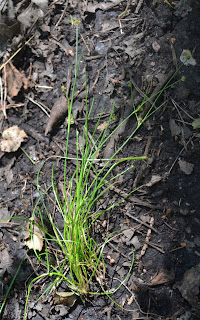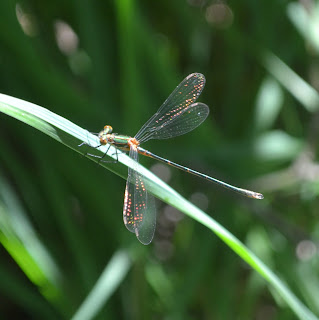19 July 2013
All day OS map 175Reading & Windsor
All day OS map 175
We parked at the
Swinley Forest Discovery Centre (aka The Lookout) SU876661 off the B3430 on the
south side of Bracknell
Ride through Bracknell Forest
Sweet chestnut in flower
Only a few rowans Sorbus aucuparia and silver birches Betula pendula remained from what must
have been the original vegetation.
Conspicuous tufts of purple moor grass Molinia caerulea were only just coming into bud, their ligules
reduced to a ring of hairs making a simple check. Hard Blechnum
spicant, lady Athyrium filix-femina
and hart's-tongue Phyllitis scolopendrium
ferns marked the lines of ditches and streams.
Lady fern
Hard fern
Other frequent
plants along this walk were bilberry Vaccinium
myrtillus, greater birdsfoot trefoil Lotus
pedunculatus, heather Calluna
vulgaris, bell heather Erica cinerea,
moor sedge Carex binervis, with its
distinct flattened tufts, slender St. John's-wort Hypericum pulchrum and wavy hair-grass Deschampsia flexuosa.
Greater birdsfoot trefoil
We kept straight
on across other major rides at Penny Hill until we almost reached the A322,
when the track bent south towards the scenic Mill Pond, which is really more of
a small lake. The clear water sported a
lot of white water-lily Nymphaea alba
and alternate water-milfoil Myriophyllum
alternifolium, but there were rarer wetland plants in the bordering
marshes, while the place was abuzz with dragonflies of many species and wood
ants colonised the dry banks under trees.
We spotted a black skipjack beetle Synaptus
filiformis on the sedges.
Mill Pond
Here was bulbous
rush Juncus bulbosus, its stem bases
showing the eponymous swelling.
Bulbous rush
Cross-leaved heath
Erica tetralix here came in for the
first time with shrubs of bog myrtle Myrica
gale and star sedge Carex echinata.
Bog myrtle by Mill Pond.
In the greater
tussock sedge Carex paniculata marsh
stood the yellow spikes of bog asphodel Narthecium
ossifragum.
Bog asphodel
Nearby pools had
marsh bedstraw Galium palustre and
lots of bog pondweed Potamogeton
polygonifolius. The leaves of some
of the latter had the white stem remains of the bog beacon fungus Mitrula paludosa, which earlier would
have had striking yellow tips.
Bog pondweed (remains of
bog beacon fungi at top of picture)
Notable
dragonflies were the emerald Lestes
sponsa and small red damselflies Ceriagrion
tenellum, black darters Sympetrum
danae and the golden-ringed Cordulegaster
boltonii and emperor dragonflies Anax
imperator.
Emerald damselfly male
Black darter female
Small red damselfly (a
Bracknell Forest BAP species)
We continued south
along rides bordered with marsh cudweed Gnaphalium
uliginosum to Rapley
Lake
Mallard and duckling on Rapley Lake
More notable,
however, were the large colonies of marsh St. John's-wort Hypericum elodes and bottle sedge Carex rostrata.
Marsh St. John's-wort
Bottle sedge
Along paths south
of the lake we came across sand spurrey Spergularia
rubra, blinks Montia fontana
Leaves of marsh violet?
Sand spurrey
There was also much of a distinctive-looking bramble with pink flowers which we had been seeing throughout this forest. We later determined it to be Rubus plicatus.
A common heathland bramble
Rubus plicatus
Although rather
early and dry for fungi we came across isolated examples of two species -
snakeskin grisette Amanita ceciliae
and The Flirt Russula vesca.
Snakeskin grisette
The Flirt
We returned to near the lake to take the large ride west to Lower Star Post, a rather barren sandy track that threw up little new except for buckshorn plantain Plantago coronopus, sand sedge Carex arenaria and heath woodrush Luzula multiflora, variety congesta with its globular flower-heads. We also saw the black-and-yellow hoverfly Chrysotoxum festivum.
Heath woodrush var. congesta
From this major confusing junction of many rides and paths, we eventually managed to select the one we wanted going SSW, a continuation of Windsor Ride. This becomes a tarmac lane and runs beside a secure fence around MoD property, but the track-sides and short turf had further interesting species. These included a small plant of vervain Verbena officinalis, a cluster of pearl everlasting just coming into flower, cut-leaved bramble Rubus laciniatus and broad-leaved helleborine Epipactis helleborine.
Pearl everlasting
Vervain
Cut-leaved bramble
Mat grass Nardus stricta (last year's dried
flowering stems standing out more than this year's flowers, because the
empty glumes stand out like a comb on one side of the stem) and heath grass Danthonia decumbens were frequent among
the common bent Agrostis capillaris
and silver hair-grass Aira caryophyllea,
and here there were also dark purple-tinged plants of the eyebright Euphrasia micrantha. Plants nearby of the common eyebright Euphrasia nemorosa had the orange rust Coleosporium tussilaginis.
Heath and mat grasses
Rust on common eyebright
We eventually took
a ride on the left down to Wishmoor Bottom, along which runs the Berks/Surrey
border. Below the trees lay a large open
heath beneath a line of pylons. Here the
heather was in flower, as it had not been in the wooded areas, where bell
heather was much more common.
Heather at Wishmoor Bottom
Here the rare
silver-studded blue butterflies were flying (another BAP species).
Silver-studded blue
Below this dry
heath was the bog that occupies Wishmoor Bottom itself. The very rare crested buckler fern Dryopteris cristata is supposed to grow
here, although mostly on the Surrey side of the border, only a very few plants
having ever been found on the Berks side.
We did not find any, although there were lots of narrow buckler fern Dryopteris carthusiana both in the shade
of trees and out in the open bog.
Narrow buckler fern
Here we saw
round-leaved sundew Drosera rotundifolia,
common cotton-grass Eriophorum angustifolium,
marsh willowherb Epilobium palustre,
heath spotted orchid Dactylorhiza
maculata, bog asphodel, cross-leaved heath and wood sage Teucrium scorodonia.
View across Wishmoor
Bottom
Marsh willowherb
Bog asphodel among
cross-leaved heath, Wishmoor Bottom
Heath spotted orchid
Round-leaved sundew
From Wishmoor
Bottom we walked back to Lower Star Post and north from there back to our
starting-point. A new pond near the
Reservoirs was choked with alien parrot's-feather Myriophyllum aquaticum, perhaps introduced with white water-lily
planted there. It is to be hoped it does
not spread to natural water-bodies in the forest.
Parrot's-feather
Close to The
Lookout we passed a shrub of bladder senna Colutea
arborescens, another alien species established particularly in the London





































No comments:
Post a Comment